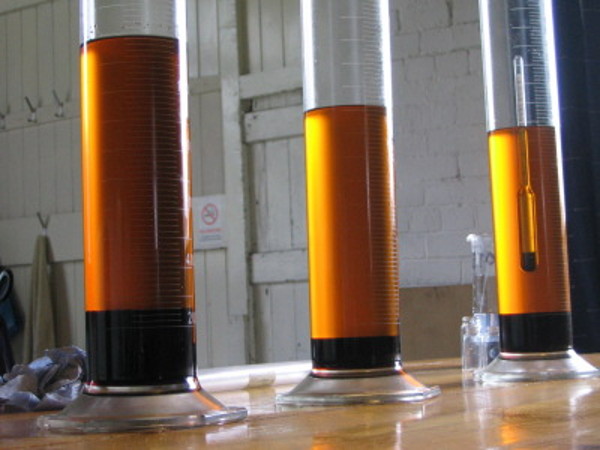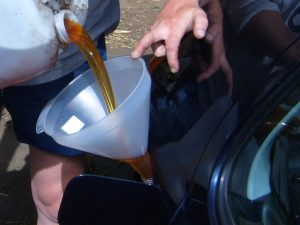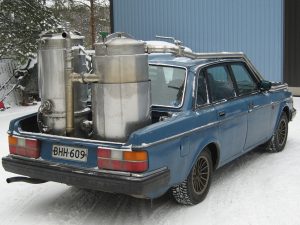Biodiesel - introduction

“The biodiesel we use has no petroleum in it. It was already used in fryers throughout our local area. It’s already had one life and now it’s going to be used again.” – Daryl Hannah
Contents
What is biodiesel?
NB: of course, this topic is slipping out of fashion as diesel vehicles are phased out. But in case of any level of societal collapse, this topic may still be useful to be able to run any existing diesel engines.
Biodiesel is a fuel for conventional diesel engines made from plant (or animal) oils or fats that have been chemically transformed into alkyl esters. Its properties are similar to mineral diesel, but it doesn’t have to be drilled from the ground. Any plant oil can be made into biodiesel, including algae. In fact one of Rudolf Diesel’s first engines was exhibited at the Paris exhibition of 1902 running on pure peanut oil. It can be made perfectly well from waste cooking oil.

We only support the use of biodiesel made from used cooking oil. We don’t think it’s a good idea to take up more land to grow crops for vehicles when there are so many people who don’t have enough food, and there is so much pressure on natural habitats. Large corporations are producing it from palm oil grown in huge plantations in West Africa and South-east Asia. We think that biodiesel from these sources is at least as environmentally-damaging as mineral diesel – see BiofuelWatch for more info. Even making biofuels from algae doesn’t stack up.
This means that we’re not advocating a wholesale change to biodiesel for all the world’s diesel vehicles, as there’s nowhere near enough waste cooking oil. But it’s something that can be done on a small scale, using a local waste product. Ultimately, we need to find ways to reduce our fuel use – including driving less, working from home, holidaying without flying and more fuel-efficient transport options.

Plant oil is too viscous to be used directly in a diesel engine, so one of two things needs to happen:
- the vehicle is modified to run on straight veg oil, or
- the veg oil is modified to be used in a normal diesel engine
No. 2 is biodiesel production. The oil is modified by making the gylcerine drop out with a chemical reaction and heat, so that it’s no longer too viscous, and can be used in any vehicle with a diesel engine, either neat, or mixed with mineral diesel. It can also be used in generators, boats, or as a heating fuel.

What are the benefits of biodiesel?
- Climate change: the most important greenhouse gas is carbon dioxide (CO2), which is emitted by the burning of fossil fuels. Burning biodiesel also emits CO2, but this is offset by the fact that it comes from plants, and plants use CO2 from the atmosphere to grow
- Emissions: tests have shown that it is cleaner burning than normal diesel with only a slight loss in range (how far a vehicle can go on a full tank) of 3-5%. Alkanes, carbon monoxide (CO) and particulates are reduced; only nitrous oxides may stay the same or increase, but can be reduced with a catalytic converter, and / or by altering the engine timing. Sulphur is almost completely eliminated. As well as being good for the atmosphere, this can increase operator safety on vehicles such as waste collection trucks, and the smell is much more pleasant than with conventional diesel vehicles
- Spills: it reduces the risk of spills from oil tankers; small biodiesel spills and leaks from vehicles are harmless
- Waste reduction: it can reduce waste by recycling used oil. (the UK produces 100-400,000 tonnes of waste cooking oil each year)
- Energy balance: biodiesel has an energy balance of 3:1, i.e. it provides 3 times the amount of energy used to produce it. (compared to not much more than 1:1 for mineral diesel)
- Biodiesel is more lubricating than mineral diesel, and so can extend engine life
- Being able to drive past a petrol station and knowing that you don’t have to give money to giant oil companies

What can I do?
First, learn as much as you can. Here’s a free pdf of our book, How to Make Biodiesel: from waste cooking oil, which covers the benefits, chemical reactions, equipment and production methods. This was published in 2005, and so some parts will be out of date (around legislation for example) – but it still contains a lot of useful info.
Using biodiesel
You can buy biodiesel (you’ll have to do a bit of online research to find suppliers of biodiesel from waste oil), or make your own. You can use 100% biodiesel in the summer and maybe think about a 50:50 blend of biodiesel and mineral diesel in the winter – biodiesel is more viscous at lower temperatures, so the fuel pump has to work harder with a cold start.
As biodiesel is a strong solvent, you need to change your fuel filter after the first 500-1000 miles, as it could remove material from the walls of your fuel tank and deposit it in the fuel filter. This should only happen once though.

Check your vehicle’s warranty to see if it covers the use of biodiesel. Many do, but many don’t, so you’d be taking a risk. Obviously it’s fine after the warranty has run out.
There is a question mark over whether to use it in common-rail diesels and modern, computer-controlled engines. There is a risk that the more precise fuel injectors may become clogged by the slightly more viscous biodiesel, or that the computer may be confused by the oxygen in it into thinking that water is present, and various ‘safety’ features may kick in. The complexity of modern vehicles seems tailor-made to prevent people from tinkering with their vehicles and their fuel – but plenty still do. On forums many state that they’re using 100% biodiesel with modern engines. Maybe a B30 (a blend of 30% biodiesel, 70% mineral diesel) would be better. There’s no such risk with older vehicles.
A group of intrepid Aussies make biodiesel from waste cooking oil collected from local restaurants.
Making biodiesel
Processors
You’ll need a processor to make biodiesel. You can buy one, or if you’re handy, you can make one with a couple of oil drums, a pump, filter, copper pipe and plumbing fittings. It might be cheaper (and more fun) to get together with friends to make or buy a processor.

Raw materials
You can buy used cooking oil cheaply (or maybe get it for free from local restaurants – as long as big producers haven’t completely cornered the market) as well as the other chemicals that are needed.

Method
Extreme care must be taken when making biodiesel, as it requires the use of potentially hazardous materials. The area must be well-ventilated, no naked flames, and use goggles and gloves. Any good recipe book or website will include a list of safety precautions. Here’s an overview of the process:
- Remove excess water from the oil by evaporation or heating and drawing off the bottom when it settles
- Filter the oil
- ‘Titrate’ a sample of oil to work out the quantity of catalyst to use in the reaction: this is a little school-chemistry-lab-type project involving isopropyl alcohol and a pH indicator
- Mix and heat the oil with alcohol (usually methanol) and a catalyst (‘lye’ – sodium or potassium hydroxide) in a processor
- When the mixture settles, draw off the glycerine from the bottom (which can be used to make soap and other useful products – after recovering excess methanol from it)
- ‘Wash’ your biodiesel with water to remove impurities
- Filter again and de-water to produce finished biodiesel
This is a basic method, and there are variations / other methods. See book (above) for more information.

Testing, regulations & duty
If you buy biodiesel, duty is already paid, but if you make it, contact HM Revenue & Customs to ask about current rates of duty payable (which is constantly changing), and the Environment Agency about what permissions you need (although you probably won’t need any permits for domestic-scale production). There are companies that can test the quality of your biodiesel.






3 Comments
Hello,
I am a trainee journalist in Cardiff University.
I am currently writing a piece about diesel cars with a focus on their decline and replacement by petrol and electric cars.
I want to know if this trend is affecting biodiesel users and makers at all.
It would be great to speak with someone who makes and uses their own biodiesel about the experience of the fuel. Let me know if you are interested and drop me an email at [email protected]
Thanks,
David Lynch
My son began making biodiesel from waste oil in 2005 armed with a copy of the Lili manual. It is a superb instruction manual and inspired his science career. He has just been awarded a PhD in combustion physics as a result. The vehicle he used ran on his own biodiesel from 2005 until late last year, when he crashed it. Thank you Lili for your inspiration and guidance, it has worked out extremely well for Ben.
Hi Cheryl. I’m passing this on to Jon Halle, who ran our biodiesel courses and wrote the manual. He’ll be chuffed! (but not about the crash, obviously).